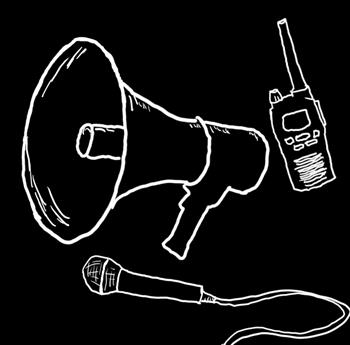Section: Info
Protest Communications

General
- Swallow the mic: for microphones, walkie talkies, and earpieces, people generally overestimate how far their mouth should be from the microphone. At a protest, generally the mic should be 2-3 inches from your mouth.
- Speak loudly: people tend to assume amplification means they do not need to project their voice. Wrong!
- Speak clearly: with all devices, slow yourself down, speak clearly, and enunciate. If you are nervous, take a deep breath.
- Mind what you say: do not widely broadcast something that can needlessly create panic. Choose your words carefully, or communicate face-to-face. Do not announce things like “lost child” or “person getting away from abuser”, as it can attract predatory people. Do not implicate people in illegal actions over communications unless critically necessary.
- Rechargeables: if you have someone else’s bullhorn or walkie, it is rechargeable, and you need to use it but cannot recharge it, keep the rechargeable battery with the device. Attach it on with duct tape or something.
- White people: make sure you are making room for members of marginalized groups, especially when at a protest for those groups.
-
SALUTE: When communicating possible threats, use SALUTE (sorry for the military acronym, but it works). Bold items are most often critical in a protest:
- Size (number of people)
- Actions (what are they doing)
- Location (east, front of march, near the speaker, etc.)
- Uniform (appearance - how can they be recognized by others)
- Time seen if not current
- Equipment (are they armed? with what?)
Bullhorns
- Check battery before use.
- Keep sound turned all the way down until you use it. Turn sound off when done.
- Do not start shouting into a bullhorn pointing directly at someone’s ear. Step away or raise the angle of the bullhorn.
Walkie Talkies
- Check walkie battery and channel before using.
- Hold down talk and say something like "mic.check" when you turn on your walkie to ensure others can hear you.
- There is a delay between you pressing the talk button and broadcast. Wait a second before speaking.
- Be extra sure to speak clearly on walkies.
- Do not clog up walkie communications with anything but necessary information.
- Remember, walkies are not secure, even if using CTCSS or DTS - what you say may be heard by others, and what you hear may not be from a trusted party.
- Be very careful about not accidentally pressing the talk or call buttons.
- Use an earpiece to make it easier to hear and to prevent third parties from overhearing your walkie.
- In a crowd, walkies may be hard to hear, even with an earpiece. If information is critical, communicate face-to-face personally or send a runner.
- Turn your walkie off at the end of the action.
- Walkie setup (applies to most common walkies, but not all):
- Most walkies have a menu button and arrow keys to navigate.
- Use arrows to select items in the current menu, and the menu button to go to the next menu.
- Channel number is usually the first menu item.
- When you are done, press the talk button to leave the menu.
Phones at Actions
- Phone usage is generally discouraged at protests. Phones rely on data networks, wifi, and bluetooth - all of which can be unreliable or compromised at a protest. People looking at their phones tends to distract them from the protest.
- If someone must monitor something on a phone at an action, assign someone that job and keep other people off their phones.
- If phones must be used in place of walkies, calls from encrypted applications over headsets are the least bad option.
- Use a password to lock your phone at actions, and disable fingerprint and facial recognition. You cannot be forced to type a password. You can be forced to use biometrics.
Information Security
Authorities will target activists, and targeting is generally based upon prejudices, not whether the activists are engaged in dangerous or illegal practices. For that reason, information security is important in all areas of activism, no matter how tame your actions and intentions are.
-
People claim a bunch of nonsense about digital security. Anything on a digital device can be compromised if that device is in the hands of authorities or if the device is on a network.
- “It’s secure because it’s on Signal” is bullshit. All you need is one device that has been compromised by spyware or one unreliable person in a conversation and encryption is now meaningless. Activist devices are regularly compromised, and activist groups are regularly infiltrated.
- But on the other hand, authorities usually don’t have time or interest to try to spy on you for details of a small, peaceful protest. Go ahead and use Signal - just don’t say anything you wouldn’t want read into the record in court.
- Still, don’t make it easy for people to spy on you - use encrypted programs.
- Trust programs like Signal over applications owned by tech firms that make money from compiling your personal information, such as WhatsApp.
- Remember that if a device is compromised, the microphone and camera can be used to spy on those around it
- Similar boundaries hold true for things like email and online documents: authorities probably aren’t interested in reading your material about a family-friendly 200 person march; but one compromised person or device gives access to everything; so, mind what you put in the cloud.
- Encrypted collaboration tools help, but again, encryption solves nothing if someone with access has been hit by spyware or is an infiltrator.
-
Use security features on applications
- Secure Zoom settings so participation can be controlled
- Setup admins for Signal groups
- Don’t use anonymous invite links to activist chats
- Secure documents by individual as much as possible
- Check with others before providing access to chats/documents/accounts to unknown people
- If you are planning something like civil disobedience, black bloc, or direct action; the safe way to plan it is in person, with only trusted people, in a room with no electronics
-
To reduce risk of compromise:
- Turn off phones and computers when possible at actions
- Keep devices locked
- Run malware detection software on PCs and phones
- Do not open suspicious documents or visit suspicious sites
- If your device is acting suspicious, backup, wipe it and start fresh
- If someone is arrested, remove their access until you know they and their devices are not compromised
Edward Crowell
04-08-2024 13:39
01-01-2025 21:14
